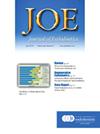评估下颌第一磨牙下牙槽骨神经阻断术成功与否的冷牙髓测试和电牙髓测试
IF 3.5
2区 医学
Q1 DENTISTRY, ORAL SURGERY & MEDICINE
引用次数: 0
摘要
导言:对牙科的恐惧往往是由于过去的痛苦经历造成的,这也是阻碍患者看牙医的一个重要障碍。实现有效的疼痛控制至关重要,尤其是在根管治疗期间。然而,下牙槽神经阻滞(IANB)的成功率很低,受焦虑、解剖变异和技术限制等因素的影响,导致麻醉失败。尽管许多研究都在评估局部麻醉的成功率方面对冷冻试验和 EPT 进行了研究,但还没有建立起标准化的方法。本研究评估了电牙髓试验(EPT)和冷冻试验在评估下颌第一磨牙症状性不可逆牙髓炎(SIP)患者麻醉深度方面的有效性:对 50 名符合纳入标准并表现出嘴唇麻木的 SIP 患者进行了横断面研究。在使用 IANB 并确认嘴唇麻木后,对所有患者进行了冷测试和 EPT。随后,开始准备进入腔道(金标准测试),患者在腔道准备过程中的反应记录为 "出现疼痛或不适 "或 "无疼痛或不适",分别表示 IANB 失败和成功。分别计算了每种测试和连续测试的灵敏度(SN)、特异度(SP)、阳性预测值(PPV)、阴性预测值(NPV)、阳性和阴性似然比(LR-/+)、准确度(AC)及 95% 置信区间(CI):结果:56%的患者被确定为IANB失败。诊断测试(冷冻测试和 EPT)的比较分析表明,SN、NPV 和 AC 没有显著差异;但冷冻测试的 SP、PPV 和 LR+ 较高。将冷冻测试和 EPT 评估结合起来可提高 SN、NPV、PPV 和 LR-,但 SP 和 AC 与单独的 EPT 相似。在 IANB 成功率与患者年龄、性别或初始疼痛之间没有发现相关性:结论:尽管有嘴唇麻木的证据,但在疼痛性牙髓炎病例中仍有大量的 IANB 失败。冷测试的阳性结果强烈表明麻醉失败。本研究的结果表明,当冷冻测试结果为阴性时,有必要使用 EPT 进行进一步评估,以确认麻醉成功并确保疼痛得到完全控制。本文章由计算机程序翻译,如有差异,请以英文原文为准。
Evaluation of Cold and Electric Pulp Tests for Assessing the Success of Inferior Alveolar Nerve Block for Mandibular First Molars Diagnosed with Symptomatic Irreversible Pulpitis
Introduction
Fear of dentistry, often due to past painful experiences, is a significant barrier preventing patients from visiting dentists. Achieving effective pain control, especially during root canal treatments, is crucial. However, inferior alveolar nerve blocks (IANBs) have a low success rate, influenced by factors such as anxiety, anatomical variations, and technique limitations, leading to anesthesia failure. Although numerous studies have examined the cold test and electric pulp test (EPT) in assessing the success of local anesthesia, no standardized method has been established. This study evaluated the effectiveness of EPT and cold tests in assessing the depth of anesthesia in patients with symptomatic irreversible pulpitis in the mandibular first molar teeth.
Methods
A cross-sectional study was conducted on 50 patients with symptomatic irreversible pulpitis who met the inclusion criteria and exhibited lip numbness. Following the administration of the IANBs and confirmation of lip numbness, cold tests and EPT were performed on all patients. Subsequently, the preparation of the access cavity (gold standard test) was initiated, and patients' responses during cavity preparation were recorded as either “presence of pain or discomfort” or “absence of pain or discomfort,” indicating IANB failure and success, respectively. Sensitivity (SN), specificity (SP), positive predictive value (PPV), negative predictive value (NPV), positive and negative likelihood ratios, and accuracy (AC) with 95% confidence intervals were calculated for each test separately as well as for sequential testing.
Results
IANB failure was determined in 56% of the patients. A comparative analysis of diagnostic tests (cold test and EPT) showed no significant difference in SN, NPV, and AC; however, the cold test had higher SP, PPV, and positive likelihood ratio. Combining cold test and EPT evaluations improved SN, NPV, PPV, and negative likelihood ratio, but SP and AC were similar to EPT alone. No correlation was found between IANB success and patient age, sex, or initial pain.
Conclusions
Despite evidence of lip numbness, a significant number of IANBs failed in cases of painful pulpitis. A positive result from the cold test strongly indicated anesthesia failure. The findings of the current study suggested that when the cold test yielded a negative result, further evaluation with EPT was necessary to confirm anesthetic success and ensure complete pain control.
求助全文
通过发布文献求助,成功后即可免费获取论文全文。
去求助
来源期刊

Journal of endodontics
医学-牙科与口腔外科
CiteScore
8.80
自引率
9.50%
发文量
224
审稿时长
42 days
期刊介绍:
The Journal of Endodontics, the official journal of the American Association of Endodontists, publishes scientific articles, case reports and comparison studies evaluating materials and methods of pulp conservation and endodontic treatment. Endodontists and general dentists can learn about new concepts in root canal treatment and the latest advances in techniques and instrumentation in the one journal that helps them keep pace with rapid changes in this field.
 求助内容:
求助内容: 应助结果提醒方式:
应助结果提醒方式:


